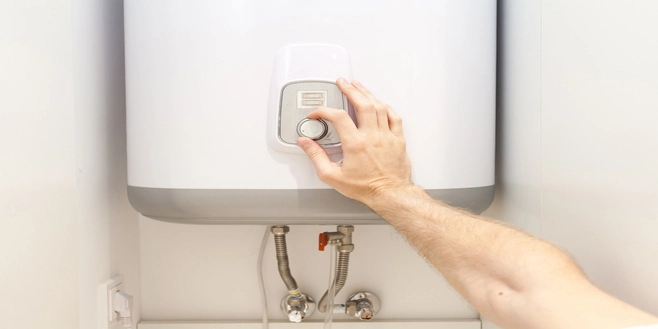
Changing Your Thermostat Dial Safely
Most modern water heaters have a sticker with instructions explaining how to adjust the temperature. Over time, this sticker can become illegible due to natural wear and tear. We’re here to help if you are having trouble finding instructions or an owner’s manual to guide you through setting the temperature.
According to The US Department of Energy, the suggested water heater temperature is 120°F. Setting your water heater at this temperature should increase energy efficiency, prevent scalding, and mitigate mineral buildup in your heater and pipes. Nevertheless, there are specific situations where increasing the temperature on your water heater’s thermostat may prove beneficial.
Always be careful when tinkering with your water heater’s temperature. Changing the thermostat invites many hazards, including a heightened risk of water burns and scalding. Don’t hesitate to call Mr. Rooter Plumbing of Virginia Beach if you’re unsure what to do. Our plumbing specialists will arrive promptly with industry-grade tools, years of experience, and the training necessary to handle any water heater situation.
Reasons to Increase Your Water Temperature
There are certain cases where raising your water heater’s temperature above the recommended level is justified. Be aware that any temperature increase will reduce your water heater’s energy efficiency, accelerate wear and tear, and put your family at risk of scalding. Always inform everyone in the household of thermostat changes. For extra precaution, we can install temperature-regulating devices and mixing valves on faucets/taps.
That said, here are some unique situations that warrant elevated water temperatures:
- Your tap water smells unpleasant – There may be a bacteria issue in your water tank if you notice a sulfurous or musty odor. Increasing your hot water temperature to 140°F for 24 hours might kill the mold spores and bacteria.
- You suffer from a chronic respiratory or immune system disorder – Immunocompromised individuals are highly susceptible to any exposure to bacteria. Raising the water heater can help kill germs and viruses before they exit your faucets.
- You have an outdated dishwasher – Many older dishwashers cannot preheat water. Keeping your water heater between 130°F or 140°F can increase sanitation.
Carefully Reset Your Water Temperature by Testing & Labeling
First and foremost, don’t forget to shut off the electricity to your water heater before adjusting the temperature. The thermostat dial on an electrical water heater usually sits behind the screw-on panels/plates. The thermostat dial on a gas water heater should be near the gas valve. Always record the initial temperature (preferably with a permanent marker) and alert anyone in your home before adjusting the thermostat.
Avoid using water for an hour after moving the temperature dial to let the heater adjust. Then run hot water at the faucet closest to the water heater to fill a pot or cup. Quickly insert a cooking or candy thermometer to check the temperature. If the temperature is still not ideal, follow the same procedure. Multiple tests may be necessary to find your preferred temperature. Once you’ve located the thermostat, mark the dial for future reference.
The Ideal Water Temperature
Hot water is a luxury many homeowners cherish. Unfortunately, some water tanks and heaters have a limited hot water supply. Simply raising the hot water temperature usually won’t cut it. Instead of offering more hot water, this technique will more likely increase the temperature and shorten the supply – putting you and your family at risk of scalding.
In such cases, you might consider replacing your water heater altogether. We can install tankless heaters that provide an endless supply of soothingly warm water. Raising the thermostat on your water heater can boost your dishwasher and shower temperatures if you struggle to reach satisfying temperature levels.
There are many reasons for unsatisfactory water temperatures, including heat loss in your pipes, broken shower faucets, and unseen leaks. As a result, you may want to inspect your faucets and water fixtures before adjusting the thermostat. One way to gauge faulty fixtures is to test the discrepancy of water temperatures at different faucets. Your water heater is likely not the issue if your sink dispenses hot water, but your showers are cold.
Save Energy & Maximize Comfort with Professional Services
Are you looking to cut back on monthly energy costs? Water heaters might be a wise place to start, given they use 14-18% of a home’s energy consumption (on average). One way to save energy is to lower the heater’s temperature: A 10°F reduction equates to approximately 3-5% savings. Regardless of your desires, our technicians have the tools and technologies to ensure you receive optimal benefits with minimum energy consumption!
We might also recommend updating your faucets to increase your capacity to adjust the temperature at the receiving end. In fact, we can install all sorts of fixtures, including a water tank booster to keep your tank extra hot or a hot water circulating system to slowly circulate hot water in your pipes so distant faucets don’t take forever to heat up.
Regardless of your needs, we’re ready to help! Let us troubleshoot your hot water heater problems today – call us or contact us online for a complimentary consultation!

